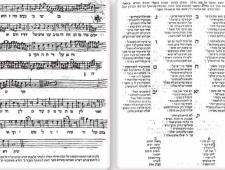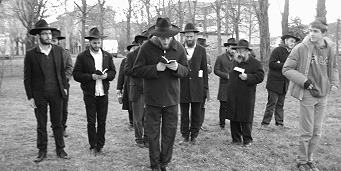L’chatchila Ariber: The Story Behind The Song
The niggun that expresses the Rebbe Maharash’s approach to life is called “L’chatchila Ariber” • In the biography that the Rebbe wrote about the Rebbe Maharash, he says that the source of the Rebbe Maharash’s inspiration was the book written by the mekubal R’ Emanuel Refael Chai Riki. • This is the inspiring story of a niggun and the story of a tzaddik and mekubal. • Presented for Beis Iyar, the birthday of the Rebbe Maharash, pulled from the Beis Moshiach Archives • Full Article
There are Jewish communities that have not been written about much in magazines and other literature because they disappeared from the world without leaving a trace. That is the way it is with Italian Jewry, which produced Torah greats and giants of spirit throughout the thousands of years of exile.
The exile of Italy, particularly in the late 17th century and early 18th century, enjoyed unprecedented growth. Mosdos Torah flourished, there were strong k’hillos, and numerous Torah scholars pored over tomes of Torah wisdom. One of these Torah giants was the mekubal, Rabbi Emanuel Refael Chai Riki (1688-1743).
Rabbi Emanuel was born in Ferrara, Italy, on 15 Tamuz 5448/1688, to Reb Avrohom and Sarah. He was orphaned at a young age. When he was 19 he took the wanderer’s staff and went to the city of Garessio, where he served as a melamed to the children of one of the residents of the city.
In the introduction to one of his s’farim, he describes his strong desire to learn kabbala from Rabbi Binyomin HaKohen who lived in Rovigo at the time, where he had lived previously. Unfortunately though, just as he arrived, Rabbi Binyomin left town and Rabbi Emanuel had to retrace his steps without attaining his goal.
After he married, he wandered to several other cities while writing his s’farim Maasei Chosheiv and Chosheiv Machshavos. Then he decided to move to Eretz Yisroel where he lived in Tzfas and studied the writings of the Arizal and the writings of the Arizal’s great disciple, Rabbi Chaim Vital. He wrote another work, his third, Hoin Ashir on Mishnayos.



Eretz Yisroel is acquired with suffering and Rabbi Emanuel experienced numerous troubles. His only daughter died in a plague. Rabbi Emanuel was forced to leave Eretz Yisroel. On his way back to Italy, his ship was attacked by pirates who took him and his family captive. However, as soon as they arrived in Tripoli, a wealthy person ransomed them.
After a brief stay in the city, he moved to Livorno, Italy where he wrote Mishnas Chassidim. He wanted to write a book that would briefly summarize the teachings of kabbala according to the Arizal, a sort of “Mishna Torah” of kabbala. He arranged it like the Six Orders of the Mishna, with divisions into tractates, chapters and Mishnayos.
After living in Livorno for three years, he began his wanderings once again and moved to Florence where he served as rosh yeshiva and mora horaa. Four years later, due to a medical problem, he returned to Livorno where he lived another twelve years.
When he was fifty, he decided to print his other compositions. For this purpose, he left his family and city and took up traveling once again, stopping in Izmir, Salonika, Kushta (Istanbul), Amsterdam, and London. In each city he fund-raised and sold his s’farim. When he finally returned home he decided the time had come to go back to Eretz Yisroel. In 5494, he made aliya once again.
Rather than living out the rest of his days in tranquility, his life of wandering and adventures continued. The sages of Eretz Yisroel deemed him fit to be a shadar (Shlucha D’Rabanan – fundraiser) to go abroad and raise money to support the Jewish settlement. He did not refuse their request and considered it another opportunity to print the additional s’farim he had written.
At this time, there were many wars in Italy and the roads were not secure. Bandits abounded and a bearded Jew walking alone was easy prey, all the more so when this Jew was a shadar carrying cash. Tragically, Rabbi Emanuel Refael Chai Riki was found lying on the road near the city of Cento in the Bologna district of Italy, strangled by his t’fillin straps. It took a week before the authorities allowed him to be brought to burial and even then, without a gravestone. Although a week had passed since his death, his body remained intact and people marveled at this.
AT THE TZADDIK’S GRAVE


 Years passed and the Jewish community in Italy was destroyed in the Holocaust. The tzaddik’s grave was forgotten.
Years passed and the Jewish community in Italy was destroyed in the Holocaust. The tzaddik’s grave was forgotten.
A group of Jews who treasured his legacy wanted to find his gravesite although a stone had never been placed on the grave. After examining city maps and taking measurements, a gravestone was placed where the tzaddik’s grave was estimated to be. According to experts, the placement of the stone is precise to within mere centimeters, even though nearly 270 years have passed since he was buried.
Rabbi Eliyahu Dovid Borenstein, shliach in Bologna, is very knowledgeable about the history of Italian Jewry. When he heard that the tzaddik was buried in his area, he had an idea. On the tzaddik’s yahrtzait in 2011, a minyan of bachurim from the Chabad yeshiva in Venice went to his grave, learned a selection from his Mishnas Chassidim and recited Kaddish.
THE TZEMACH TZEDEK SAID ABOUT HIM: “EVERYTHING HE SAYS IS FROM THE ARIZAL”
The Mishnas Chassidim is one of the few s’farim of the later kabbalists quoted in Tanya – two times!
The Tzemach Tzedek testified about him, “Everything he says is from the Arizal.” Therefore, one should be stringent about customs he brings down, more than other customs. The Rebbe Maharash in a number of places in his maamarim explains different ideas from his works, and the Rebbe also cites his s’farim many times.
Rabbi Tzvi Hirsch of Ziditchov (1763-1831) writes in his Tzvi LaTzaddik that the Mishnas Chassidim is quoted extensively by the disciples of the Baal Shem Tov, “and certainly they ratified and received from Rabbeinu HaBaal Shem Tov HaKadosh zy”a regarding the holiness and trustworthiness of this holy seifer.”
THE INSPIRATION FOR THE NIGGUN “L’CHAT’CHILLA ARIBBER”
It appears that the connection with Chabad Chassidus runs a bit deeper.
All Lubavitchers know the niggun of the Rebbe Maharash, “L’chat’chilla Aribber.” The niggun is thus named because of the descending movement that represents milmala-l’matta as in the Rebbe Maharash’s statement, “The world says, ‘If you can’t crawl under [an obstacle], try to climb over,’ but I say, at the outset, one should climb over!’”
The niggun is also called “Niggun Ohr Ein Sof” (Infinite Light) or “Niggun Eintz, Tzvei, Drai, Fir” (One, Two, Three, Four).
This niggun has a special connection with Rabbi Emanuel. At the end of his Hoin Ashir, he printed a song that he wrote about t’fillin and Shabbos. The Rebbe Maharash, who was musically talented, read the musical notes and this inspired the famous “L’chat’chilla Aribber” niggun.
The Rebbe writes, “In addition to his [the Rebbe Maharash’s] genius and greatness in all parts of Torah, Nigleh and Nistar, he possessed amazing talents and a phenomenal memory. For example, at the end of Hoin Ashir by the author of Mishnas Chassidim, there is a song written in musical notation. The Rebbe Maharash read it and said that it inspired him to compose a niggun, and he then proceeded to sing the famous niggun known amongst Chassidim as ‘Eintz, Tzvei, Drai, Fir,’ the niggun ‘Ein Sof.’”
239
Join ChabadInfo's News Roundup and alerts for the HOTTEST Chabad news and updates!











































